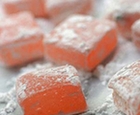|
Turkish Dessert Turkish Delight Turkish Delight is a wildly popular candy throughout the Middle East. You may have run across it in C.S. Lewis’s, The Lion, the Witch, and the Wardrobe.
Sugar & Lemon Juice: in a saucepan over medium heat, combine 1 1/2 C water in a saucepan with sugar and lemon juice. Stir continually till sugar dissolves; then bring the mixture to a boil. Reduce heat, immediately, and simmer. Once the mixture reaches 240 degrees on a candy thermometer, remove from heat. Cornstarch: in another saucepan, combine remaining 2 3/4 C water with cream of tarter and only 1 C of the cornstarch. Stir over medium heat till mixture is smooth and it reaches a boil. Stop stirring once it attains a glue-like consistency. Combine: Add sugar/lemon juice mixture to cornstarch mixture. Stir 5 minutes. Simmer gently for 1 hour, stirring frequently. After an hour, stir in the rosewater. Pour mixture into 9" square baking pan, coated with vegetable oil spray. Allow to cool on the counter overnight. Cut & Serve: The next day, flip the baking pan over onto the counter and use an oiled knife to cut the candy into 1" pieces. Coat with confectioner's sugar mixed with the remaining 1/4 C cornstarch. Layer the candy between wax paper and store in an airtight container. |
Tips & Glossary You may not have all the ingredients used in Turkish cooking on your spice shelf, but you'll find them at Middle-East food stores. To avoid frustration, make a list of items you need before trying out the recipes. Cumin: an aromatic, kin to parsley and carrots; an important ingredient in chili powder. Used especially in Indian curries, as well as in Mid-Eastern, Mexican, and Asian dishes. It has an earthy, peppery flavor. Filo: aka phyllo, paper-thin sheets of raw, unleavened flour dough. Buy frozen in any grocery store and follow directions on package for thawing. When working with one sheet, keep others covered with a damp towel to prevent drying out. Peeled Tomatoes: choose 1 of 2 methods: 1) hold tomatoes one-at-a-time over gas flame till skin bubbles and becomes charred; 2) drop all tomatoes into pot of boiling water for 45 seconds. After either method, run tomatoes under running water; skins will slip off easily. Roasted peppers: buy them prepared. Or make your own: place peppers under a broiler, or hold over a gas flame, till skin chars and blisters. Place them in a closed paper bag for 15-20 minutes (to steam them). When cool enough to handle, the skins slip off under running water. Rosewater: distilled from rose petals and used to flavor Mid-Eastern and Asian cooking. You can make your own—but why? Purchase it at Mid-East or Asian or food stores. Saffron: the most expensive spice in the world, from the crocus plant, and cultivated in Iran and Spain. Along with its unusual taste, it adds a deep rich yellow color to food. Use a strand or two at a time and soak in warm water before using. Skewers: use metal or wooden skewers for kabobs. If wooden, be sure to soak them for 30 minutes before using to prevent them from catching on fire.
|
Site by BOOM
![]()
LitLovers © 2024

